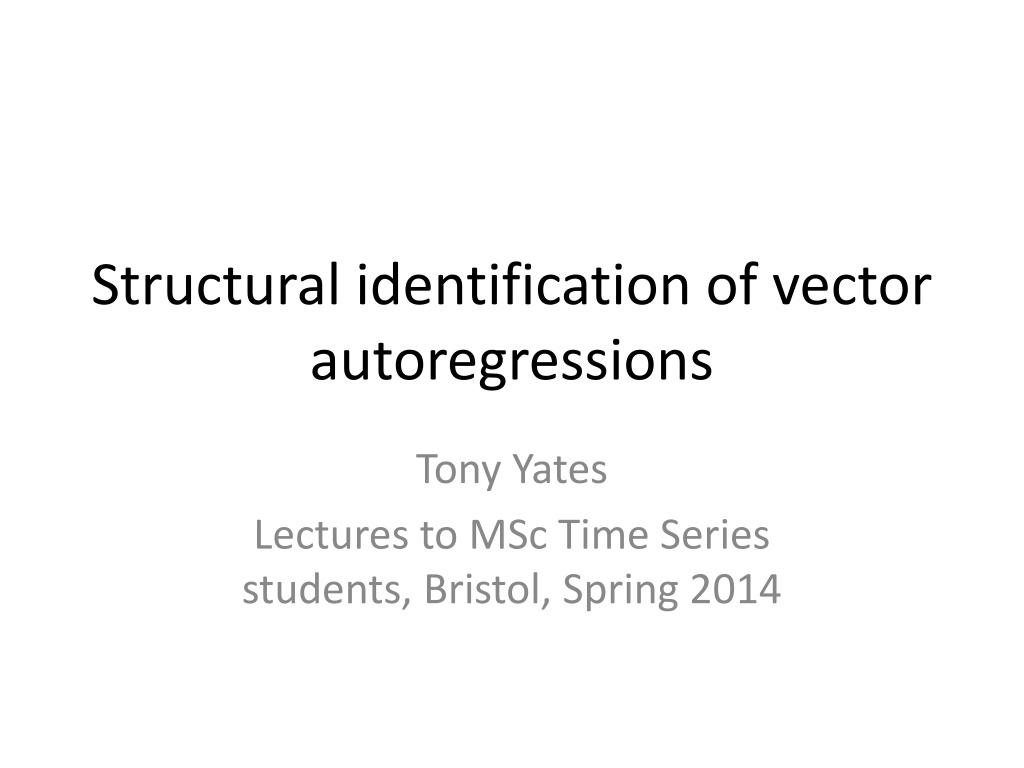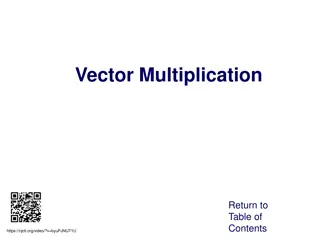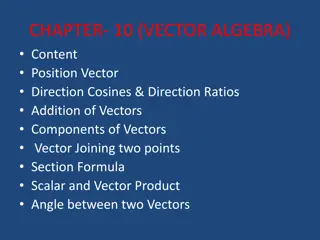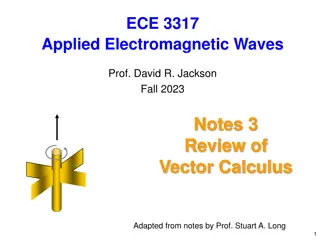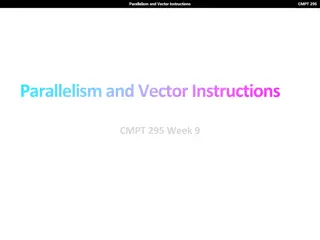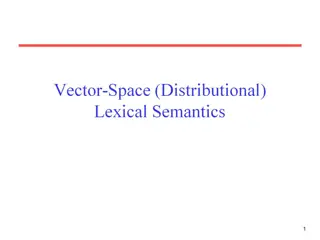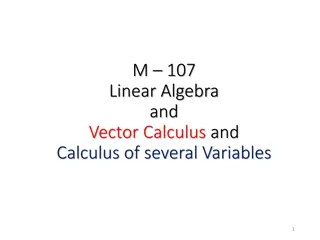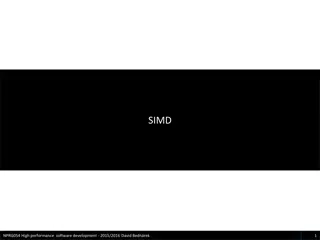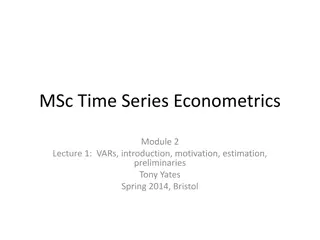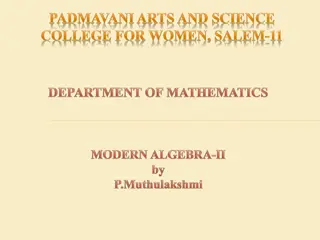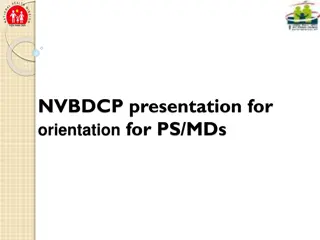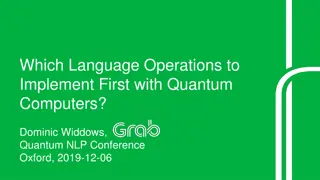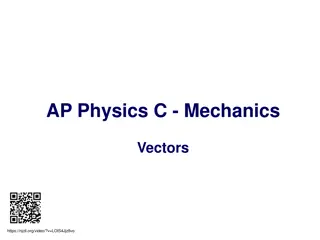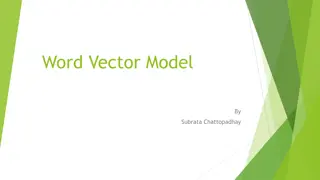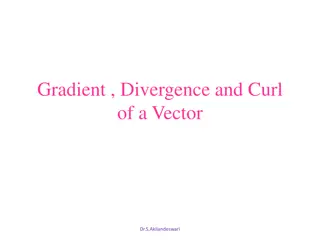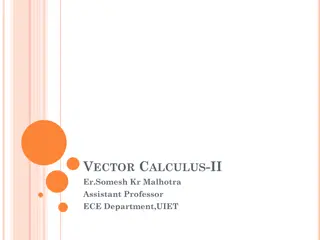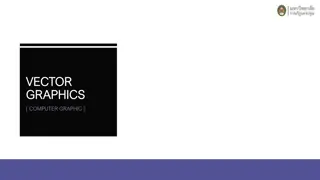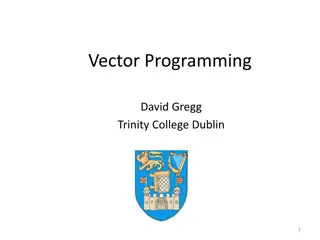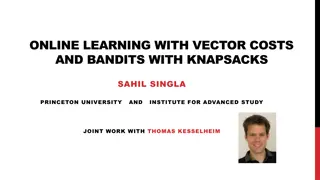Understanding Structural Identification in Vector Autoregressions
Explore the algebra of identification problems in VARs, including Cholesky factorization, timing restrictions, long-run impact restrictions, sign restrictions, and identification through heteroskedasticity. Discover why structural identification is crucial for policy design, economic modeling, and understanding shocks in business cycle theory. Learn about the difference between reduced form and structural models in VARs and the challenges in recovering structural shocks and coefficients. Gain insights into the ideal factorization of the reduced form vcov matrix in structural identification.
Uploaded on Sep 30, 2024 | 0 Views
Download Presentation

Please find below an Image/Link to download the presentation.
The content on the website is provided AS IS for your information and personal use only. It may not be sold, licensed, or shared on other websites without obtaining consent from the author. Download presentation by click this link. If you encounter any issues during the download, it is possible that the publisher has removed the file from their server.
E N D
Presentation Transcript
Structural identification of vector autoregressions Tony Yates Lectures to MSc Time Series students, Bristol, Spring 2014
Overview The algebra of the identification problem in VARs. Cholesky-factoring; timing restrictions. Long run impact restrictions. (Max share restrictions). Sign restrictions. Identification through heteroskedasticity.
Some useful sources Luktepohl, Hamilton. Kilian survey. Wouter den Haan lecture notes Karl Whelan lecture notes Many more!
Why bother with structural identification Empirical form of business cycle accounting, which is important for informing policy. Eg if RBC claim that tech shocks dominant true, maybe no need for stabilisation policy? Not needed for forecasting. Needed for estimation of our economic models, eg impulse response function matching. Hence needed to understand appropriate policy design. Eg identify a policy shock.
Lucas(1980) on why identifying shocks is important Methods and problems in business cycle theory, JMCB
Reduced form vs structural model for Y We are estimating this VAR(p), in the vector Y.... Yt A1Yt 1 A2Yt 2 A3Yt 3 ...ApYt p et B0Yt B1Yt 1 ...BpYt p ut I B L Yt ut ..in order to learn about this structural model, with different coefficients, and driven by structural shocks Structural shocks mutually uncorrelated, and normalised so that vcov matrix is identity=dimension of Y u IK E utut
Structural vs reduced form VARs 1B0Yt B0 Yt B0 Ai B0 1B1Yt 1 ...B0 1B1Yt 1 ...B0 1Bi,et B0 1BpYt p B0 1BpYt p B0 1ut 1ut B0 1ut Once we have estimated the reduced form VAR for Y, if only we knew the B_0, we could recover the sructural shocks, and ALL the coefficients of the structrual model. If only!! Structural identification is about trying to find B_0. Long and controversial story. We will tell it chronologically.
Idealised factorisation of the reduced form vcov matrix 1E utut 1 uB0 1 B0 1 B0 e B0 e B0 1B0 1 LHS known; RHS elements unknown. System of nonlinear equations. Need to restrict B_0 so that have same number of unknowns as equations. Sigma_e is symmetric, as it s a vcov matrix, hence has K(K+1)/2 independent elements only. B_0 not necessarily symmetric Referred to as order condition for identification.
Simple illustration of the identification problem in 2 dimensions We estimate this 2 variable reduced form VAR(1) to learn about this 2 variable structural VAR. y1 y2 e1 e2 Yt AYt 1 t t b0,11 b0,12 b0,21 b0,22 b1,11 b1,12 b1,21 b1,22 y1 y2 y1 y2 u1 u2 t 1 t t 1 1 b1,11 b1,12 b1,21 b1,22 b1,11 b1,12 b1,21 b1,22 b1,11 b1,12 b1,21 b1,22 y1 y2 y1 y2 u1 u2 t 1 t t Here we invert the coefficient matrix B0 so that the structural VAR has the same form as the reduced form VAR. Which allows us to see relation between rf and structural errors .
Identification problem in 2 dimensions, ctd e1 e2 e1 e2 e,11 e,21 e,21 e,22 e E 1 1 2 2 b1,11 b1,21 b1,21 b1,22 b1,11 b1,12 b1,21 b1,22 b1,11 b1,12 b1,21 b1,22 2 2 First line: we compute the vcov matrix of reduced form errors which we see has only 3 separate elements. Second line: we note that this is equal to inv(B0)*inv(B0) . Problem: this is a 2*2 with 4 independent unknown elements. We have only 3 knowns to find these 4 unknowns. This is the identification problem in VARs/SVARs.
Cholesky identification P is lower triangular Used eg to identify a monetary policy shock Assumes strict causal chain in the VAR GDP and inflation don t react within period to a monetary policy shock. e PP ,P chol e P B0 1 0 0 0 0 xt t it p11 p21 p22 p31 p32 p33 p11 p21 p22 p31 p32 p33 ux u ui B1Yt 1 ... Yt 0 0 t For those studying DSGE models. Third equation looks like a central bank reaction function. But it isn t! Coefficients of the central bank reaction function will show up in all of the VARs reduced form equations. See, eg, Canova comment on Benati/Surico paper.
Recovering the monetary policy shock and structural coefficients with Cholesky identification 0 0 ex e ei p11 p21 p22 p31 p32 p33 ux u ui 0 t t eit p31uxt p32u t p33uit eit p31uxt p32u t p33 uit 1Bi Ai B0 1 0 0 p11 p21 p22 p31 p32 p33 B1 A1 0
Finishing the 3d monetary policy shock eit p31uxt p32u t p33 Our expression for the mon pol shock u_it was in terms of some unknowns. uit ext p11uxt uxt ext/p11 Here we can get rid of one of them, u_xt. e t p21uxt p22u t p21ext/p11 p22u t Here we get rid of the second, u_pit, also using expression for u_xt e t p21ext/p11 p22 u t And we are done. u_it now entirely in terms of knowns.
Impulse responses to the structural shocks 1u u B0e e B0 irf AhB0e Yh We can use the reduced form VAR estimates to compute the response to structural shocks. Our structural shocks are functions of the reduced form shocks, a function of our assumed value for B_0. So we then feed these through the reduced form VAR in the normal way, taking successively higher and higher powers of the A matrix.
Problems with recursive structure implied by Cholesky identification Is it economically plausible? Quarterly data. Does output or inflation really not respond to interest rates within the quarter? Assumed causal ordering means we can t use the VAR to find out about causality. Common practice to check for robustness to alternative causal orderings, but this is rarely done comprehensively; and [so Kilian says] is nonsensical!
Recap on causal assumptions in Cholesky identification of mon pol shock Neither e_x nor e_pi are functions of the structural shock u_it. 0 0 ex e ei p11 p21 p22 p31 p32 p33 ux u ui 0 Implies output gap and inflation do not respond [within the period] to a monetary policy shock. t t t E t 1 xt u t xt Ext 1 it E t 1 uxt it t xxt uit Is this really plausible? Remember the NK DSGE model. If we trace the timing of the effects of the monetary policy shock, we can see that it affects inflation and the output gap straight away. Of course, the NK model could be a load of nonsense!
More problems with recursive identification. Sims and the price puzzle . Would find that recursively identified, contract mon pol shock leads to increase in prices, contrary to theory. Concluded that had omitted variable cb responding to, eg commodity prices. CP up means prices up, despite central bank rate increase.
Recursive ID problems: omitted variables Omitted variable bias leads us to enlarge the VAR. But there is a cost: imprecision in the coefficients. And the search for more restrictions. Solutions: Bayesian shrinkage and factor modelling to reduce dimensionality. In time we will cover both of these.
What are these mp shocks anyway? Why would policymakers induce shocks? Are they really conducting experiments for their own edification [a control literature involving Sargent, Cogley shows there is a benefit]. Alan Blinder says not. Shocks are just misspecifications by econometrician Shocks are policymakers real time measurement error? Shocks are policymakers [or our] model mis- specification Same goes, of course, for fiscal policy shocks.
Alternative, less intensive measures of identifying (eg) mp shocks Romer and Romer (1989) narrative measures of monetary policy (and fiscal policy) shocks. Rudebusch (1998): gap between actual Fed Funds Rate and expectations implied by Fed Funds futures.
Romer and Romers narrative shock definition Problem: they are including movements in rates prompted by concerns about inflation. So if we think i=a*pi+b*y+shock, they are not identifying m p shocks
Romer and Romer(1989), quoting Friedman and Schwartz (1964)
Rudebusch, and Sims on Rudebusch Rudebusch: FFFs produce better forecasts than VARs. His surprise a better measure of policy shocks . Sims (1996): 1. False premise. FFR shocks confound surprises due to non policy shocks with those due to shocks. 2. Not true that if shock measures badly correlated, estimated effects are very different.
Famous applications Rotemburg and Woodford (1998). Early application. Estimated DSGE model by fitting IRFs of monetary policy shock using MDE. Later pointed out that in DSGE model EVERYTHING responds within the period to monetary policy. Christiano, Eichenbaum and Evans (2005) Same exercise. But DSGE model is consistent with timing assumption.
Minimum distance estimation mde argmin Y Y A, e DSGE model is defined by a vector of parameters, PHI. We take as our PHI_hat the value of these parameters that makes the impulse response in the DSGE model as close as possible to the identified, estimated IRF in the VAR. Some costs and benefits wrt eg MLE estimation of DSGE model. Cost: partial information, means bad identification. Benefit: MLE only consistent if model well-specified.
Identification using long run restrictions Attractive because much agreement on certain long run restrictions. So these are credible in Sims language. At least among members of the RBC/DSGE cult [like me]! Famous early applications are Blanchard and Quah (1989), and Gali (1999). More later. Technique sparked famous arguments between Chari et al and VAR proponents, notably Christiano and coauthors.
Egs of restrictions uncontroversial, at least in DSGE/RBC-land Nominal shocks should have no long run impact on real variables. Corrollary: only real shocks should have a long run impact on real variables. Real shocks like technology should be neutral on inflation in the long run. Only inflation regime changes should affect inflation in the long run.
Deriving long run restrictions for an SVAR Reduced form VAR(1) with an expression in terms of structural shocks and the unkown structural impact matrix substiuted in place of the RF shock 1ut Yt At 1 B0 1 impact period: B0 1 period after: AB0 2 periods after:A2B0 nperiods after:AnB0 This is how we would compute the IRF to the structural shock, if only we knew the structural impat matrix.... 1 1 1 You can see this defines an infinite sequence. Effect on level of something=0, implies sum of effects on difference=0.
Deriving long run restrictions 1 AB0 1 A2B0 1 ... AnB0 1 1 D B0 I A A2 ...An B0 D I A 1B0 Factor the long run IRF in terms of something you might recognise from high school as the expression for an infinite geometric series, or its matrix equivalent. 1 i 0 1 ai 1 a Some algebra and we spot that DD involves something we can estimate from the data, the vcov of the RF residuals! 1B0 1 I A 1 DD I A 1B0 I A 1 e I A 1
Long run restrictions and the Cholesky factor, again 1B0 1 I A 1 DD I A 1B0 DD which we know to be related to the magic B0 which we are trying to find we also know to be related entirely to things we do know. I A 1 e I A 1 D chol I A 1 e I A 1 1 I A 1 D B0 B0 1 I A D
Galis (AER, 1999) search for technology shocks log yt/ht log ht Yt Only the tech shock (which we say comes first, has a long run effect on the first variable, (the change in) output per hour 0 d11 d21 d22 D
Celebrated applications of LR restrictions Blanchard-Quah. Tech shock is the only thing to affect output in the long run. Q: how important are tech shocks in driving the business cycle? Gali (1999). Tech shock is only thing driving labour productivity. Appears to cause hours to fall, not rise. Consistent with sticky price model, not RBC models. Hours tend to comove positively with business cycle. Suggests tech shocks not dominant driver of business cycle. Christiano-Eichenbaum-Vigfussen (). Reexamination of Gali. Conclusion depends on definition of hours worked used in VAR
Identification of VARs using sign restrictions 1 0 0 0 e PP ,P chol e e PCC P ,C Givens 0 c s 0 ,c cos ,s sin 0 s 0 c 0 0 0 1 Cholesky factorisation of rf varcov can be expanded with product of any orthonormal matrix So, parameterising with the angle theta, we choose all those that satisfy certain sign restrictions sign S.PCAh R Sign is the signum function; S is a selector matrix with ones for restricted elements, 0s otherwise. C is our givens matrix. A is our estimated rf impact matrix.
Signum function and the selector matrix An example of what the signum function does to a matrix. Turns things into 0s, 1s or -1s. Just a way to record in an algorithm whether things are positive, negative or zero. Could do it differently, with more if, then else statements. 0 0.05 0 1 sign 2 3 1 1 2 6 1 0 2 6 2 0 S. . 0 1 1 0 0 1 0 0 An example of doing element by element multiplication with a selector matrix.
Verbal description of sign restrictions Take cholesky factor of vcov matrix P Multiply by some Givens, C(theta) Check signs of elements of interest. If they agree with your restrictions, store and keep. If not, move on. At the end, plot ALL the IRFs, and or summarise them somehow.
i=cb rate, pi=inflation, x=output, ur=unemployment rate it t xt urt Yt AYt 1 et Mp shock in first column: contraction raises rate, lowers pi, lowers output, lowers unemployment. 1 0 1 0 1 1 1 0 R 1 1 1 0 Tech shock in second column: reduction has ambiguous effect on i, increases pi, lowers output, ambiguous effect on ue 1 0 1 0 1 0 1 0 1 1 1 0 S Demand shock in third column: cb raises rates to fight it, inflation and output increase anyway, ue falls. 1 1 1 0 1 0 1 0 1 0 0 0 Fourth shock unidentified. A dustbin containing many things we don t need to worry about. 0 c s 0 C 0 s 0 c 0 0 0 1
Alternative way to do sign restrictions using the QR decomposition 1.LKK,Lij NID 0,1 2.L QR,QQ IK 3.C Q 4.Proceed as before Any square matrix can be decomposed into a product of an orthonormal matrix and something else. Matlab will calculate this for you in a flash. Note equivalence which seems not to be widely understood. Derives from fact that all orthonormal matrices can be shown to be product of Givens matrices. Personal preference: use Givens method. Systematic way to explore the space. Random number generators for step 1 in computers are not random, they are pseudo random. Don t know if this matters much.
Sign restrictions at different or multiple horizons Choose h the horizon, then keep IRF if it satisifies this condition sign SPC Ah R sign SPC Ah1 R,sign SPC Ah2 R For multiple horizons, keep if the condition above applied for multiple horizons holds!
Warning: spanning the entire space of possible impulse responses A givens indexed by one angle only not enough to guarantee to find all possible IRFs that satisfy the sign restriction, except in the 2 variable case [eg n=2, 2*(1)/2=1] n n 1 /2 n n 1 /2 More generally, we need to search across orthonormal matrices formed by products of Givens matrices. i 1 C i
Reporting distributions from sign restrictions n IRFh 1/n irf 1.For eachh compute: Yh, i i 1 2 2. Find argmin h Yh, i irf IRFh irf 3. Plot Yh, Sign restrictions generate arbitrary numbers of impulse response functions. How to report them? Can just plot the whole damned lot. People used to report moments at each h eg the median. Fry and Pagan suggested above. Find the single SVAR corresponding to single angle that is closest to this median.
Sign restrictions: examples Giraitis, Kapetanios, Yates. Actually a TVP study, but don t worry about that until later on in the lecture series. Sign restrictions to identify various shocks. Studies time variation in the IRFs.
Sign restrictions in Giraitis, Kapetanios, Yates w/p r c i y h monetarypolicy - - - - technology - labour supply - - demand
Identification using Mountford and Uhlig s penalty method 1. drawrotationmatrixC H 2. compute K wh SPCAh Vh SPCAh Vh h 1 3. Rank according to K w_h are weights; V records not just signs, but magnitudes. Why would you do this? Isn t it just assuming the answer? Well, one motivation is to use one implication of the model to test another, that you don t impose. Another is that some rotations may satisfy the sign restriction literally, but you want the IRF not just to clear the zero line by a tiny amount.
Using the max share criterion in a VAR to identify news shocks Barsky-Sims (2010): identified news shocks for technology. Long history of identifying technology shocks, measuring impact, quantifying contribution to business cycles RE assumption suggests agents may also react to news about future events. Failure to account for this may mislead us in properly measuring and quantifying effects of technology shocks.
Other work on news shocks Beaudry-Portier: news shocks in VARs: news causes hours to increase. Jaimovich and Rebello: news shocks in RBC model, neutralising the wealth effect so that hours don t fall. Schmitt-Grohe and Uribe (2012): multiple news shocks in large RBC style model Christiano, Motto, Rostagno and Pinter, Theodoridis and Yates: risk news shocks in DSGE model and VAR respectively
News shocks: algebra yt B L ut ut A AA t h yt h Et 1yt h B AQ t h 0 IN, K K 1 /2 1 Q Q 1 Q 2 ... Q K K 1 /2 1 Q Q A chol Note annoying change of notation; matches Barsky-Sims. Sorry. Good for the soul though. This slide is about writing down the expression for the forecast error up to horizon h.
News shocks identification, ctd... The share of the FEV up to horizon h, of variable i, accounted for by shock j... B ei h ei 0 B AQ ejej Q A i,j h h ei 0 B B ei Example news process for tfp. Could be more general than this. news tfpt tfpt 1 utfp,t utfp,t 1 1,1 h 1,2 h 1 In an ideal setting, share of current and news shock to tfp that accounts for tfp should be 1. tfp is exogenous after all!
News shocks: the max share criterion By choice of the K.(K-1)/2 vector of angles w, maximise the share of tfp forecast error variance up to horizon h, accounted for by the news shock to tfp, subject to the restriction that the news shock is orthogonal to tfp today. [if it weren t, it wouldn t be news, it would be a contemp. Shock to tfp] max i,j h subject to A 1,j 0,j 1 In Pinter, Theodoridis and Yates, in our search for risk news shocks, we impose a sign restrictions condition too. sign SA 22 F
